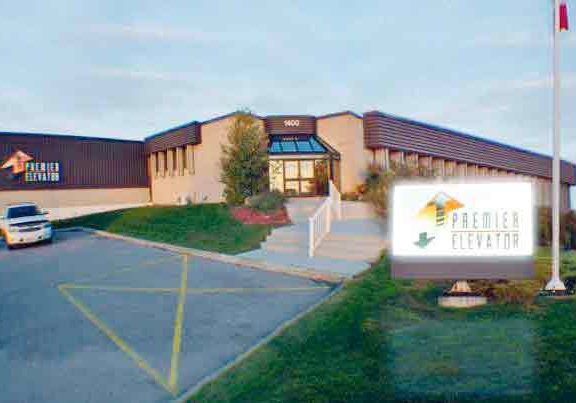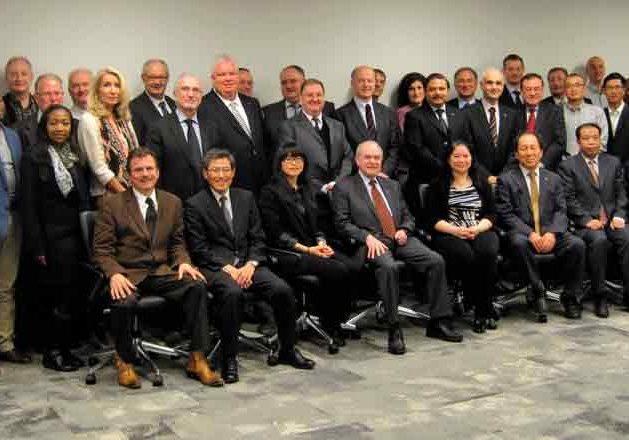Smart Elevator Tech, LLC has developed a tool that allows the operator of its Retracta Ladder® (ELEVATOR WORLD, June 2011 and February 2013) the ability to retract (raise) and extend (lower) the retractable elevator pit ladder from within the pit. The Pit Actuator is a laser-cut, formed-metal fork device welded to a 3/4-5 ACME nut, customized to fit a standard threaded broom handle or paint extension pole (not included).
The accessory was prompted by elevator companies that have begun to provide a hoistway access station within the pit, allowing the mechanic to raise and lower the car, while standing on the pit floor. This feature allows a single technician the ability to access and service the components on the base of the car, such as the overspeed safeties, rail guides, switches and other electrical components.
The Retracta Ladder must be extended (lowered) in order for the mechanic to access the pit. When extended, the retractable ladder electrical device (safety limit switch) opens the elevator safety circuit as the positive-break, normally closed contact is wired in series with the elevator pit switch. Due to the ladder’s switch, the extended ladder precludes operation of the car, even on hoistway-access operation. Therefore, a means of retracting (raising) the ladder from the pit floor, to both close the switch and to move it clear of the car path, would be necessary to take advantage of the in-pit hoistway-access operation.
The Retracta Ladder’s patent-pending T-handle pull pin, located near the top of the ladder, functions both as the manual handle/means of operation, as well as the code required mechanical locking device, to lock the ladder in both the retracted and extended positions. As such, it cannot have a defeat feature, such as a rotate lockout that otherwise would allow it to be retracted from below. The Pit Actuator, which can reach and operate the pull pin, is the intended solution to retract and extend the ladder from the pit floor.
For more information, contact Rich Blaska at Smart Elevator Tech at phone: (415) 819-5744, e-mail: [email protected] or website: www.smartelevatortech.com.
Limax33 Safe System
Elgo Electronic GmbH Co. KG now offers its LIMAX33 Safe, a shaft-imaging system designed to meet the new EN 81-1/2 and A3 code requirements and norms. LIMAX33 Safe is suitable for new installations and modernizations. The system consists of three main components: the sensor LIMAX33 RED, an evaluation unit Safe Box and magnetic tape.
The LIMAX33 RED is a redundant double sensor. The housing contains two sensor channels that are constantly monitored for functionality. If a sensor channel fails, LIMAX33 reports the error to the Safe Box or directly to a safe controller. The sensor can be mounted to the lift cabin and is able to determine the absolute position of the cabin by using magnetic tape freely suspended in the lift shaft.
In the unlikely case of the magnetic tape tearing, a safety switch, which serves as a presence detector for the magnetic tape is used. This helps ensure the system detects if the tape is torn or stuck in the sensor and taken along with the cabin either in an upward or downward direction. This results in an interruption of the safety circuit and immediately disables the lift.
The Safe Box is an electronic device that is connected on one side to the sensor via an RS485 interface and on the other side to the elevator controller via a controller area network interface. It contains redundant safety relays looped into the safety circuit of the elevator.
Conditions involving dust, dirt, humidity, smoke or high temperatures have minimal to no effect on the measurement quality, which makes LIMAX33 RED ideal for firefighter elevators.
LIMAX33 installation can be performed within a few minutes. Depending on the available space, the sensor can be mounted anywhere in the shaft. Due to its minimal space requirements, LIMAX33 RED is suitable for modernizations and reconstructions and can be used for traveling heights of up to 260 m and speeds of up to 10 mps.
For more information, contact Elgo at 1261 Hardt Circle, Bartlett, Illinois 69103; phone: (630) 626-1639; fax: (630) 626-1627; or website: www.elgo-electronic.com.
Spider Launches Spiderline
In May, Spider, a division of SafeWorks, LLC, announced its new design for the SpiderLine™ Temporary Horizontal Lifeline System, which helps provide fall protection for users working on construction projects, including bridges and other structures.
SpiderLine is engineered to be easy to install and fit multiple applications at height, and meets OSHA and Canadian Standards Association fall protection requirements.
With a maximum length of 300 ft., the new design features standard pass-through stanchions, which allow the freedom to move without having to unhook the lanyard. In addition, the wide-clamp option connects to beams up to 36-in. wide with 3- 3/8-in. flange thickness. The 12.5° vertical angle allows an open walkway for workers, and the low-profile chain eliminates trip hazards.
For more information, contact Spider at 365 Upland Drive, Seattle, Washington 98188; phone: (877) 774-3370; fax: (206) 575-6240; or e-mail: [email protected].
LED Lighting In Cab Modernizations
The two main reasons for cab modernizations are to upgrade the look of the cab and to make it more efficient. According to Draka Elevator, LED lighting is a way to do both. Standard cab lighting consists of incandescent tungsten or halogen lamps (in a fixture), or fluorescent lamps (hanging or recessed in an alcove). However, advances in technology have made LED lighting a viable choice for cab modernizations.
A comparison of these four lighting technologies includes the amount of light versus the amount of power consumed. All lamps use electrical power, measured in W, to produce light, measured in lm. The more lm per W, the more efficient the lamp. The second basis of comparison is lamp life. A long-lasting lamp does not need to be replaced as often and, therefore, has a lower replacement cost (assuming equal costs of the lamps). For fluorescent lamps, there is also the factor of a higher cost of disposal due to their mercury content. Third, there is initial expense: one style may be cheaper to operate, but if its power units and fixtures are expensive, it may not be worth the incremental savings in power. Finally, color temperature should be considered. All lamps have a signature color, usually described in terms of temperature. Generally, people prefer warm to neutral white light indoors.
Tungsten incandescent lamps are the least-efficient style, managing to convert only 2% of their supplied power into lumens. While inexpensive, they are also the fastest to burn out and need replacement. While they produce a pleasing warm light, they also produce excess heat. And, while not technically illegal, incandescent lamps will not be able to meet U.S. efficiency guidelines of legislation to be enacted in 2020.
Halogen lamps have been a popular replacement for the tungsten style. They are more efficient than tungsten (about 3.5% of their Wattage is converted to a bright white light). While more expensive than tungsten, they last longer. However, they burn much hotter, and this heat becomes noticeable in the close confines of an elevator cab.
Fluorescent lamps come in two styles: traditional tubes up to several feet in length, and compact-fluorescent lamps (CFLs) that fit into standard screw-in fixtures. Fluorescents are the most efficient of the three older technologies, converting about 8-10% of their supplied power into lumens. These lamps, especially the newer CFLs, are pricier than tungsten ones. Older fluorescents give off a slightly greenish cool light, but some newer styles produce a warmer, orange tone. They tend to flicker at 120 Hz; even if not noticeable, this can contribute to eyestrain and discomfort. And, while they last longer than the other two styles described thus far, they use mercury (a poisonous heavy metal) to produce light and require special disposal methods.
Of these three methods, fluorescent and halogen lamps are comparable in installed and operational costs, with fluorescents being a bit cheaper, and the halogen being a bit brighter. LEDs compare favorably against all of them. First, approximately 8% of their power is converted to lumens. While other types of lamps use 13-40 W per lamp to produce American National Standards Institute (ANSI)-mandated levels of illumination, an i2Systems LED uses 4 W to produce as many as 200 lm. A standard installation of nine of the company’s Apeiron LTE+ fifth-generation LEDs exceeds ANSI A17.1-2007 standards for illumination by a wide berth (61.25 lx required/97.2 lx delivered). Temperature of lamps from i2Systems are variable, available in warm (3000°K) and bright-white (4000°K) colors.
Longevity is another LED advantage. LEDs from i2Systems last four times longer than a fluorescent lamp and 20 times longer than a halogen lamp. This can translate to a substantial savings in both material and labor. Additionally, as green mandates become more prevalent, that also means fewer special disposal problems for burnt-out lamps.
The main drawback to LEDs had been their once-prohibitive cost for units that could be used to light room-sized spaces. However, fifth-generation LED cab lighting is not only within reach of many modernization budgets, it is also a leader in installed and maintained cost. Based on energy savings alone, LEDs from i2Systems typically pay back the cost of installation in less than one year, not including government rebates for energy-efficient products that may be available in a locale.
The company’s products are designed to be aesthetically pleasing. For example, its Aperion LTE+ puck-style lights come in gold, chrome, brushed nickel and black finishes, and in round and square styles. Its linear LEDs replace up to 20 ft. of fluorescent tubes with 12-, 18-, 24-, 36- and 48-in. lengths that offer focused light specifically intended to fit the ambiance of an elevator cab. In addition, i2Systems’ products allow for dimming and code-compliant battery backup, and use plug-and-play wiring. Additionally, while the lifespan of generic LEDs are calculated based on 3-6 hr. of operation per day, these products are designed for 24/7 operation.
For more information, contact i2Systems at 355 Bantam Lake Road, Morris, Connecticut 06763; phone: (860) 806-3032; fax: 860-567-2501; e-mail: [email protected]; or website: i2systems.com.
Enhanced ICB Proximity Sensors
Carlo Gavazzi Inc. has announced an enhancement to its ICB-series proximity sensors: Certifications for use in hazardous environments. By division, the improvements are:
- Class I, Division 2, Groups A, B, C and D
- Class I: hazardous locations with presence of flammable gases or vapors
- Division 2: hazardous atmospheres only present under fault conditions and only for very short periods of time
- Group A, B, C and D: Groups of explosive gases (acetylene, hydrogen, ethylene and propane)
- By zone, the improvements are:
- Class I: hazardous locations with presence of flammable gases or vapors
- Zone 1: hazardous atmospheres may be present under normal operation but only for short periods of time (intermittently)
- AEx d/Ex d: flameproof devices (AEx d for U.S.; Ex d for Canada)
- IIB+H2: Group of explosive gases (hydrogen and ethylene; valid also for group IIA — Propane)
The sensors feature the same advanced microprocessor design and AirCore™ sensing coil, along with a robust potting process intended for installation in heavy-duty applications. There are no new part numbers involved, as the Class-I, Division-2 rating is an enhancement to the existing ICB series.
For more information, contact Carlo Gavazzi at 750 Hastings Lane, Buffalo Grove, Illinois 60089; phone: (847) 465-6100; fax: (800) 222-2659; e-mail: [email protected]; or website: www.GavazziOnline.com.
Get more of Elevator World. Sign up for our free e-newsletter.










